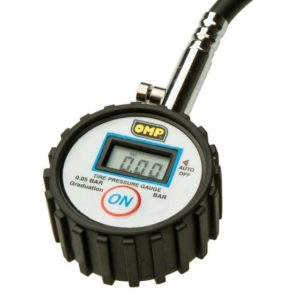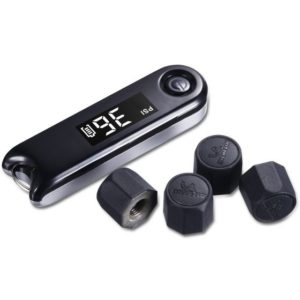Though there might be some minor variation based on load and riding conditions, your street motorcycle probably falls in the 28 – 40 psi range.
In the UK, we use pounds per square inch (psi) to measure tyre pressure. Any gauge you buy here will use this system, and the manufacturer of your bike will also have the correct pressure printed in psi somewhere in either the owner’s manual or a sticker on the bike.
Under-inflated and over-inflated tyres can make your bike handle unpredictably, causing accidents and other problems.
At the lower end of these problems, riding around on under-inflated tyres causes uneven wear and poor fuel economy.
At the more serious end, tyres that are incorrectly inflated can run hot, eventually leading to a blowout. Handling differences often play out while taking corners – with unpleasant consequences.
Save Money On Your Motorcycle Insurance
- You could pay less than £195*
- Compare quotes from 25+ UK providers
- Fill in one form to compare top bike insurers
Over Inflation
When tyres are over-inflated, we end up with a very small area of rubber in contact with the road. This creates squirrely handling, a rough ride and uneven wearing.
Over-inflation leads to tyres wearing out down the middle first. This area of the tyre is forced to absorb pressure and wear that was intended to be spread out over a wider surface area.
Tyres that are too hard also affect your bike’s ability to absorb impact from bumps in the road. Your suspension is calibrated to work in tandem with your tyres to this end.
Over-inflation increases the risk of accidents because a rider’s control is compromised when adjusting to obstacles, bumps, kerbs etc. But, the biggest drawbacks to over-inflated tyres are discomfort and premature tyre wear.
Under Inflation
An under-inflated tyre has too much surface area in contact with the road. This causes premature wear, sluggish handling and accidents. Because air molecules constantly try to escape from your tyre, under inflation is a more common problem than over inflation.
Tyres lose around 1psi every month. And, every 5-degree change in ambient temperature also loses the tyre another 1psi.
In the UK, all this can add up to a significant loss of pressure over time. If your bike has been sitting up a few weeks, you should get your pressure gauge out.
How To Avoid This Problem
Squeeze
At the very least, a motorcyclist should squeeze-check their tyres before every trip. I learned this the hard way, only realising there was a problem when miles from home.
I got off lightly with a long walk and an expensive motorcycle recovery fee. (Editors note: Perhaps Donal should have invested in motorcycle breakdown cover!)
Consequences can be much worse.
After a few months of riding, you know how your tyres should feel. Check them by squeezing the tyre wall before riding – no matter how short the trip.
Of course, this is by no means definitive. Squeezing your tyres is the bare minimum – what you should do if you don’t have a more sophisticated option available. Thankfully, more sophisticated options are often inexpensive.
Gauges
Note: Read our full, in-depth article about motorcycle tyre pressure gauges.
Whether you go analogue or digital, pressure gauges are fairly inexpensive. Accuracy, durability and features all increase with cost, but even the cheapest gauge is a lot more accurate than squeezing the tyre.
Analogue gauges are cheap and don’t require batteries. However, they are prone to damage from knocks and bumps. And because they depend on moving parts, their accuracy will decrease over time and require recalibration.
Digital pressure gauges are slightly more expensive but tend to remain accurate for longer. They also aren’t as prone to gunking up, sticking or damage from knocks as their analogue counterparts.
Tyre Pressure Monitoring System
Note: Read our full article on Tyre Pressure Monitoring Systems.
A tyre pressure monitoring system is installed permanently to your bike, usually giving you real-time feedback on pressure and alarms in an emergency.
Most of these systems come in the form of two dust caps which replace the original ones on the valves. These new caps take a pressure reading every few seconds and send the data to either a display mounted on your handlebars or to your smartphone.
When To Check
The usual response here is “every two weeks”. We’d like to point out that this advice is given as a bare minimum, and if you ride every day – there’s no harm in checking your tyres more often.
Many people choose to check their tyres at service stations, but these gauges are often abused and rarely (if ever) calibrated. Your best bet is to buy a cheap gauge and check your pressure at home.
Note: A pressure reading should always be taken when the tyres are cold (meaning before you ride). Tyres heat up with use, and a pressure reading taken afterwards will be affected by this temperature change.
Weight Considerations
There’s an argument to be made that any rider who regularly corners hard, rides under a heavy load or maintains high speeds over long stretches of road should increase the pressure in their tyres.
Lets be honest though, this doesn’t apply to a lot of riders. It doesn’t apply to us – and we’ve been riding for more than twenty years.
Motorcycle manufacturers simplify their pressure recommendations for the purposes of giving clear instruction.
The tyre manufacturer, though, often prints a range of different psi ratings on the tyre wall, suitable for different loads, speeds and riding styles.
The most important thing to remember here is that we can never exceed the max psi rating printed on the tyre.
And, the safest bet for the vast majority of people is using the psi recommended by your bike’s manufacturer.
Should I Reduce Pressure In Wet Weather?
The problem here is – one group of people will tell you to reduce pressure in the rain to increase the surface area in contact with the road thereby increasing traction. While another camp will tell you to increase pressure in the rain to help punch through the film of water on the road and prevent hydroplaning.
Presented with these two conflicting pieces of advice, we suggest you follow neither. Keep your tyres at the psi printed in the user’s manual or on the bike itself. It’s easily the smartest bet.
Related
Everything you ever wanted to know about tyre tread depth.
How to fix a puncture and motorcycle puncture repair kits.




